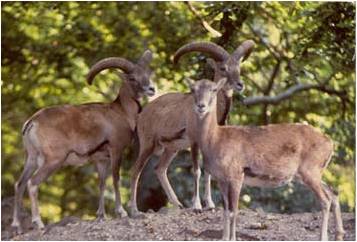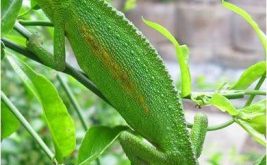Name: Cyprus mouflon
Scientific name: Ovis orientalis ophion
Family: Bovidae
Endemism
The Cyprus mouflon is estimated to have lived on the island for more than 8,000 years and is thought to be a descendant of a wild sheep of Asian descent brought to the island by prehistoric humans. After the extinction of the deer from Cyprus in the 19th century, the Cyprus mouflon remained the largest terrestrial mammal on the island. It is a unique subspecies in the world, although other species of wild sheep are found in many parts of Europe in Asia and North America.
Description
Males always have horns, while females may or may not have them. Their horns make an almost complete rotation and are about 85 cm long. Wild animals are cowardly animals and can hardly be approached by humans, especially when they are scared. They are flexible and move very quickly even in the steep areas of the Paphos forest where they live. The male Cyprus mouflon at the age of 3-4 years, is a strong, well-made and beautiful animal with heavy horns in the shape of a sickle. His hair is heavy and dense and has a light brown color, with a light gray on the back.
Habitat
The Cyprus mouflons today is found in a mountainous, wooded area about 700 km (with the core of the Paphos State Forest) in the northwestern part of the island. During the summer, the wild habitat lives in the high mountains of the Paphos forest and mainly in the area of Tripilou. Tripylos is located at an altitude of about 1,300 meters and dominates the cedar valley. In winter, when there is snow on the high peaks, the Cyprus mouflons go down to lower areas to find food.
Reproduction
Mating takes place in the fall. The Cyprus mouflons give birth in April-May. Usually only one Cyprus mouflon is born at a time, sometimes two. Newborns are very lively, almost from the time they are born, and this is so that they can escape the many dangers that threaten them.
Food
It feeds mainly on herbaceous rather than woody or shrubby vegetation throughout the year. During the summer it usually feeds in the afternoon until the early hours of the morning, while in winter it lasts throughout the day. In summer, due to the intense drought and consequently the decrease in the quality and quantity of herbaceous vegetation, it also feeds on bulbous plants, leaves and shoots of trees and shrubs and various fruits and berries such as cloves, acorns, berries, wild grapes, etc.
Protection
In Cypriot law, it is defined as a strictly protected subspecies and is classified in Annex IV of the European Union’s Guidelines for the Protection of Biotopes as a species that needs strict protection. Its active management and protection has resulted in an increase in the wild population from a few dozen in the 1930s to more than 3,000 today, the Cyprus mouflon is still considered rare because it exists only in Cyprus.
Sources:
[1] http://www.moi.gov.cy/moi/Wildlife/wildlife_new.nsf/web06_gr/web06_gr
[2] http://el.wikipedia.org/wiki/%CE%91%CE%B3%CF%81%CE%B9%CE%BD%CF%8C
[3] Κυπριακά είδη πανίδας και χλωρίδας και τύποι οικοτόπων. Υπουργείο Γεωργίας, Φυσικών Πόρων και Περιβάλλοντος-Υπηρεσία Περιβάλλοντος.
[4]http://www.moa.gov.cy/moa/fd/fd.nsf/0/C9CC5FA8B2190A8EC2257A28003774EB/$file/%CE%A4%CE%BF%20%CE%9A%CF%85%CF%80%CF%81%CE%B9%CE%B1%CE%BA%CF%8C%20%CE%B1%CE%B3%CF%81%CE%B9%CE%BD%CF%8C%20(2).pdf
Image sourse:
https://cites.org/
 Κυπριακό Κέντρο Περιβαλλοντικής Έρευνας & Εκπαίδευσης – Κυκπεε
Κυπριακό Κέντρο Περιβαλλοντικής Έρευνας & Εκπαίδευσης – Κυκπεε




